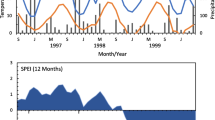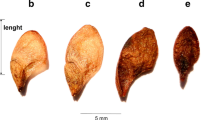Abstract
The seed and seedling mortality ofFagus crenata Blume after a mast year (1993) was examined in relation to density and distance from the nearest conspecific adult tree in a mixed conifer-hardwood forest in Ohdaigahara, western Japan. The mortality of fallen seeds during winter amounted to 93.7%, and 79.2% of the current-year seedlings died in the first growing season. The most important factor of death for both seeds and seedlings was predation by vertebrates. The mortality of seeds during winter was positively correlated with sound seed density. The mortality of seedlings was positively correlated with density but not significantly related to the distance from the nearest crown edge of a conspecific adult tree. Mortality patterns varied with stages and spatial scales due to the behavior of predators; it is thus important to investigate the spatial pattern of seeds and seedling mortality at various temporal and spatial scales. After the first growing season, the difference in seedling density between distance classes was not significant at <4m from the nearest adult trees due to density-dependent mortality. However, seedling density was significantly lower in the ≥4 m class than in the <4 m classes.
Similar content being viewed by others
References
Burkey T. V. (1994) Tropical tree species diversity: a test of the Janzen-Connell model.Oecologia 97: 533–540.
Clark D. A. &Clark D. B. (1984) Spacing dynamics of a tropical rain forest tree: evaluation of the Janzen-Connell model.American Naturalist 124: 769–788.
Connell J. H. (1971) On the role of natural enemies in preventing competitive exclusion in some marine animals and rain forest trees. In:Dynamics of Populations (eds P. J. den Boer & G. Gradwell) pp. 298–312. Center for Agricultural Publishing and Documentation, Wageningen.
Fox, J. F. (1977) Alternation and coexistence of tree species,American Naturalist 111: 69–89.
Hashizume H. &Fukutomi A. (1978) Development and maturation of fruits and seeds inFagus crenata.Journal of the Japanese Forestry Society 60: 163–168 (in Japanese with English summary).
Hashizume H. &Yamamoto S. (1974) Seed bearing of beech trees (Fagus crenata Blume) in the Chugoku district of Japan. II. The fertility and character of seeds.Journal of the Japanese Forestry Society 56: 393–398 (in Japanese with English summary).
Houle G. (1992) Spatial relationship between seed and seedling abundance and mortality in a deciduous forest of north-eastern north America.Journal of Ecology 80: 99–108.
Hubbell S. P. (1979) Tree dispersion, abundance, and diversity in a tropical dry forest.Science 203: 1299–1309.
Hubbell S. P. (1980) Seed predation and the coexistence of tree species in tropical forests.Oikos 35: 214–229.
Janzen D. H. (1970) Herbivores and the number of tree species in tropical forests.American Naturalist 104: 501–528.
Jensen T. S. (1985) Seed-seed predator interactions of European beech,Fagus silvatica and forest rodents,Clethrionomys glareolus andApodemus flavicollis.Oikos 44: 149–156.
Kamata N. (1996) Interaction between beech trees and population dynamics of its herbivorous insects: Induced response against defoliator and predator satiation hypothesis.Japanese Journal of Ecology 46: 191–198 (in Japanese).
Kikuzawa K. (1988) Dispersal ofQuercus mongolica acorns in a broadleaved deciduous forest. 1. Disappearance.Forest Ecology and Management 25: 1–8.
Miguchi H. &Maruyama K. (1984) Ecological studies on a natural beech forest (36). Development and dynamics of beechnuts in a mastyear.Journal of the Japanese Forestry Society 66: 320–327 (in Japanese with English summary).
Murai H., Yamaya K., Kataoka H. &Yui M. (eds) (1991)Natural Environment and its Conservation on Buna (Fagus crenata)forest. Soft Science Inc., Tokyo (in Japanese).
Nakashikuza T. (1988) Regeneration of beech (Fagus crenata) after the simultaneous death of undergrowing dwarf bamboo (Sasa kurilensis).Ecological Research 3: 21–35.
Nakashizuka T. &Kohyama T. (1995) The significance of the asymmetric effect of crowding for coexistence in a mixed temperate forest.Journal of Vegetation Science 6: 509–516.
Nilsson S. G. (1985) Ecological and evolutionary interactions between reproduction of beechFagus silvatica and seed eating animals.Oikos 44: 157–164.
Price M. V. &Jenkins S. H. (1986) Rodents as seed consumers and dispersers. In:Seed Dispersal (ed. D. R. Murray) pp. 191–235. Academic Press, Sydney.
Runkle J. R. (1981) Gap regeneration in some old-growth forests of the eastern United States.Ecology 62: 1041–1051.
Sahashi S., Kubono T. &Shoji T. (1994) Temporal occurrence of dead seedlings of Japanese beech and associated fungi.Journal of the Japanese Forestry Society 76: 338–345.
Shimizu Z. (1987) Ecological distribution and reproduction of small mammals on Mt. Ohdaigahara in the Kii Peninsula.Nanki Seibutsu 29: 29–36 (in Japanese with English summary).
Terazawa K., Yanai S. &Yasaka M. (1995) Characteristics of seed production ofFagus crenata (I). Quality and quantity of fallen nuts in natural stands in south-western Hokkaido from 1990 to 1993.Journal of the Japanese Forestry Society 77: 137–144 (in Japanese with English summary).
Wada N. (1993) Dwarf bamboos affect the regeneration of zoochorous trees by providing habitats to acorn-feeding rodents.Oecologia 94: 403–407.
Woods K. D. (1979) Reciprocal replacement and the maintenance of codominance in a beech-maple forest.Oikos 33: 31–39.
Woods K. D. (1984) Patterns of tree replacement: canopy effects on understory pattern in hemlock-northern hardwood forests.Vegetatio 56: 87–107.
Author information
Authors and Affiliations
About this article
Cite this article
Akashi, N. Dispersion pattern and mortality of seeds and seedlings ofFagus crenata Blume in a cool temperate forest in western Japan. Ecol. Res. 12, 159–165 (1997). https://doi.org/10.1007/BF02523781
Received:
Accepted:
Issue Date:
DOI: https://doi.org/10.1007/BF02523781




